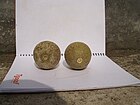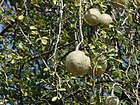Note: This is a project under development. The articles on this wiki are just being initiated and broadly incomplete. You can Help creating new pages.
Limonia acidissima - Kapitha
Limonia acidissima is the only species within the monotypic genus Limonia. It is native to the Indomalaya ecozone to Bangladesh, India, Pakistan, Sri Lanka, and in Indochinese ecoregion east to Java and the Malesia ecoregion.
Contents
- 1 Uses
- 2 Parts Used
- 3 Chemical Composition
- 4 Common names
- 5 Properties
- 6 Habit
- 7 Identification
- 8 List of Ayurvedic medicine in which the herb is used
- 9 Where to get the saplings
- 10 Mode of Propagation
- 11 How to plant/cultivate
- 12 Commonly seen growing in areas
- 13 Photo Gallery
- 14 References
- 15 External Links
Uses
Indigestion, Earache, Scurvy, Diabetes, Kidney problems, Liver problems, Snakebites, Malaria, Sore throats.
Parts Used
Chemical Composition
Fruit pulp contains large quantity of citric acid and other fruit acids, mucilage and minerals. Leaves contain stigmasterol, psoralen, bergapten, orientin, vitedin, saponarin, tannins and an essential oil[1]
Common names
| Language | Common name |
|---|---|
| Kannada | Dadhiphala, Nayibel |
| Hindi | Pushpaphal, Katabel |
| Malayalam | Vilankai, Vilarmaram |
| Tamil | Vila, Vilampazam |
| Telugu | Kapitthhamu |
| Marathi | NA |
| Gujarathi | NA |
| Punjabi | NA |
| Kashmiri | NA |
| Sanskrit | Dadhittha, Danthashatha |
| English | Wood apple, Monkey fruit |
Properties
Reference: Dravya - Substance, Rasa - Taste, Guna - Qualities, Veerya - Potency, Vipaka - Post-digesion effect, Karma - Pharmacological activity, Prabhava - Therepeutics.
Dravya
Rasa
Guna
Veerya
Vipaka
Karma
Prabhava
Habit
Identification
Leaf
| Kind | Shape | Feature |
|---|---|---|
| Pinnate | alternate | Imparipinnate, alternate, 1-3 in a cluster, estipulate; rachis 60-80 mm long, stout, glabrous, often narrowly winged; leaflets 4-7, opposite, sessile, estipellate; lamina 1.3-3.8 × 1.3 cm, obovate, base cuneate or acute, apex obtuse, margin entire, glabrous, pellucid-punctate, coriaceous; lateral nerves pinnate, obscure, intercostae obscure. |
Flower
| Type | Size | Color and composition | Stamen | More information |
|---|---|---|---|---|
| Polygamous | 1-3 cm across | Yellow | 10-12 | dull red, 1.3 cm across, in axillary cymes; calyx small, flat, 5-toothed, pubescent with out, deciduous; petals 5, free, spreading; stamens 10-12, inserted round the disc; filaments dilated below, villous on face and margins; anthers linear-oblong; disc thick, annular, pubescent; pistillode short; ovary superior, oblong, 5-6-celled, at length 1-celled, ovules many; stigma oblong, fusiform. |
Fruit
| Type | Size | Mass | Appearance | Seeds | More information |
|---|---|---|---|---|---|
| Berry | 5-7.6 cm across | globose, whitish-brown, rind hard and woody; seeds many, embedded in pulp | many | {{{6}}} |
Other features
List of Ayurvedic medicine in which the herb is used
- Vishatinduka Taila as root juice extract
Where to get the saplings
Mode of Propagation
How to plant/cultivate
A plant of the drier tropical and subtropical lowlands, where it is found at elevations up to 450 metres[3]
Commonly seen growing in areas
Photo Gallery
References
External Links
- Ayurvedic Herbs known to be helpful to treat Indigestion
- Ayurvedic Herbs known to be helpful to treat Earache
- Ayurvedic Herbs known to be helpful to treat Scurvy
- Ayurvedic Herbs known to be helpful to treat Diabetes
- Ayurvedic Herbs known to be helpful to treat Kidney problems
- Ayurvedic Herbs known to be helpful to treat Liver problems
- Ayurvedic Herbs known to be helpful to treat Snakebites
- Ayurvedic Herbs known to be helpful to treat Malaria
- Ayurvedic Herbs known to be helpful to treat Sore throats
- Herbs with Fruits used in medicine
- Herbs with Leaves used in medicine
- Herbs with common name in Kannada
- Herbs with common name in Hindi
- Herbs with common name in Malayalam
- Herbs with common name in Tamil
- Herbs with common name in Telugu
- Herbs with common name in Sanskrit
- Herbs with common name in English
- Habit - Deciduous tree
- Index of Plants which can be propagated by Seeds
- Index of Plants which can be propagated by Cuttings
- Herbs that are commonly seen in the region of Dry plains
- Herbs that are commonly seen in the region of Himalayas
- Herbs
- Rutaceae








